NURBN 1001 Essay: Ethical Principles in Adolescent Healthcare
VerifiedAdded on 2023/03/23
|7
|2400
|72
Essay
AI Summary
This essay applies the four ethical principles of Beauchamp and Childress (autonomy, beneficence, non-maleficence, and justice) to a case scenario involving an adolescent seeking contraceptive care. It discusses the complexities and dilemmas faced by healthcare providers when balancing these principles, particularly in situations involving adolescent patients. The essay explores the importance of respecting patient autonomy while ensuring beneficence and minimizing harm, considering factors such as maturity, confidentiality, and potential conflicts between ethical principles. The essay concludes by emphasizing the need for healthcare providers to act as educators, providing appropriate knowledge and counseling to patients while respecting their decisions, unless those decisions would cause significant harm.
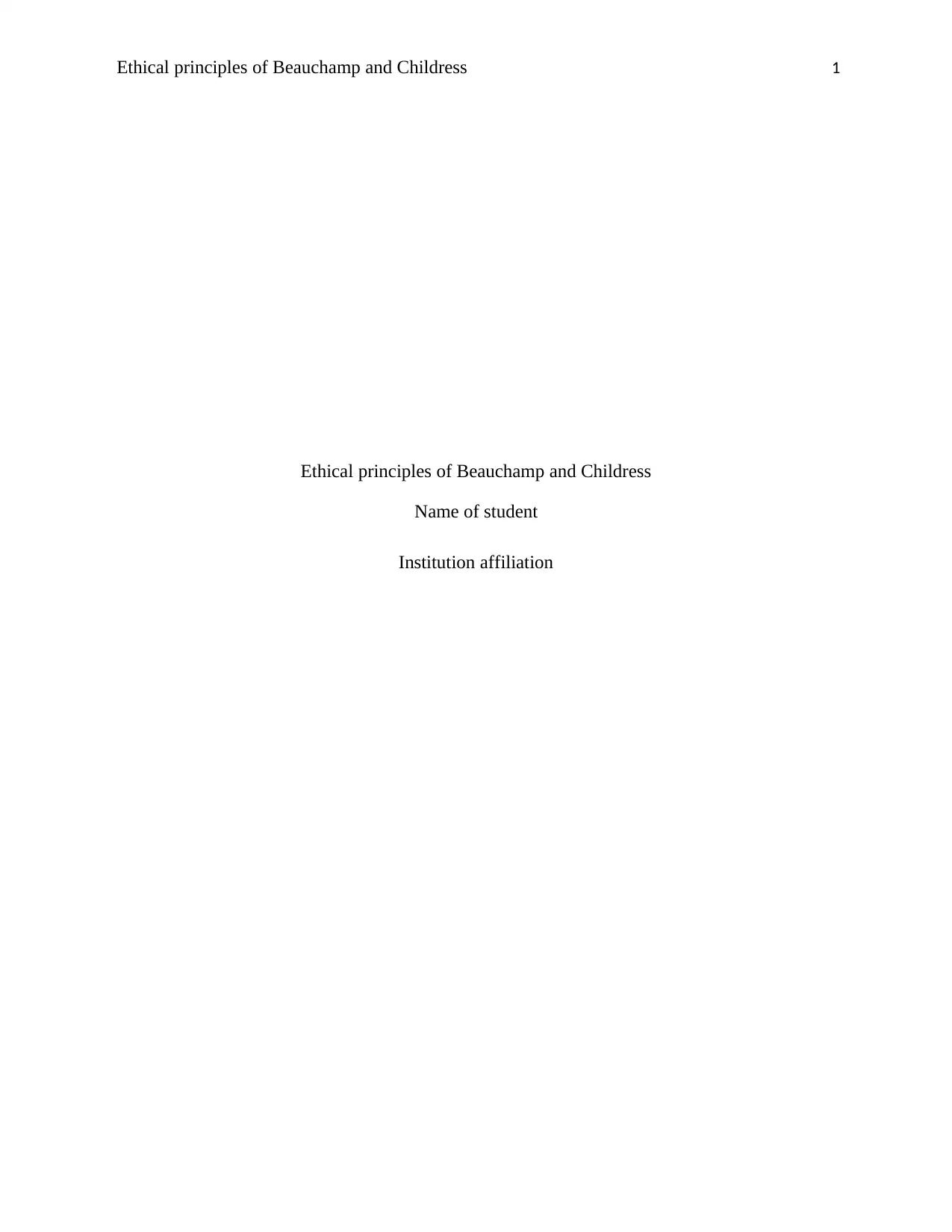
Ethical principles of Beauchamp and Childress 1
Ethical principles of Beauchamp and Childress
Name of student
Institution affiliation
Ethical principles of Beauchamp and Childress
Name of student
Institution affiliation
Paraphrase This Document
Need a fresh take? Get an instant paraphrase of this document with our AI Paraphraser
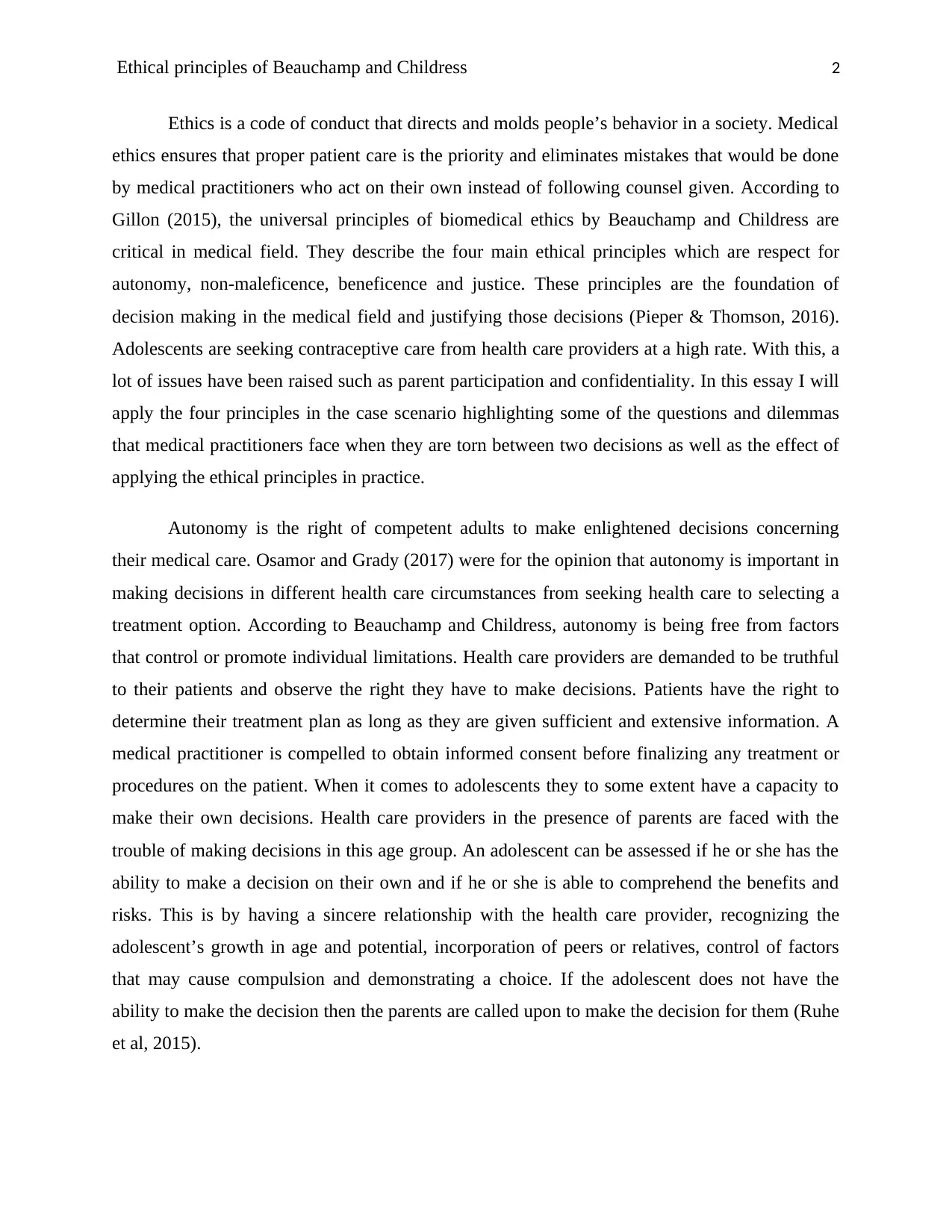
Ethical principles of Beauchamp and Childress 2
Ethics is a code of conduct that directs and molds people’s behavior in a society. Medical
ethics ensures that proper patient care is the priority and eliminates mistakes that would be done
by medical practitioners who act on their own instead of following counsel given. According to
Gillon (2015), the universal principles of biomedical ethics by Beauchamp and Childress are
critical in medical field. They describe the four main ethical principles which are respect for
autonomy, non-maleficence, beneficence and justice. These principles are the foundation of
decision making in the medical field and justifying those decisions (Pieper & Thomson, 2016).
Adolescents are seeking contraceptive care from health care providers at a high rate. With this, a
lot of issues have been raised such as parent participation and confidentiality. In this essay I will
apply the four principles in the case scenario highlighting some of the questions and dilemmas
that medical practitioners face when they are torn between two decisions as well as the effect of
applying the ethical principles in practice.
Autonomy is the right of competent adults to make enlightened decisions concerning
their medical care. Osamor and Grady (2017) were for the opinion that autonomy is important in
making decisions in different health care circumstances from seeking health care to selecting a
treatment option. According to Beauchamp and Childress, autonomy is being free from factors
that control or promote individual limitations. Health care providers are demanded to be truthful
to their patients and observe the right they have to make decisions. Patients have the right to
determine their treatment plan as long as they are given sufficient and extensive information. A
medical practitioner is compelled to obtain informed consent before finalizing any treatment or
procedures on the patient. When it comes to adolescents they to some extent have a capacity to
make their own decisions. Health care providers in the presence of parents are faced with the
trouble of making decisions in this age group. An adolescent can be assessed if he or she has the
ability to make a decision on their own and if he or she is able to comprehend the benefits and
risks. This is by having a sincere relationship with the health care provider, recognizing the
adolescent’s growth in age and potential, incorporation of peers or relatives, control of factors
that may cause compulsion and demonstrating a choice. If the adolescent does not have the
ability to make the decision then the parents are called upon to make the decision for them (Ruhe
et al, 2015).
Ethics is a code of conduct that directs and molds people’s behavior in a society. Medical
ethics ensures that proper patient care is the priority and eliminates mistakes that would be done
by medical practitioners who act on their own instead of following counsel given. According to
Gillon (2015), the universal principles of biomedical ethics by Beauchamp and Childress are
critical in medical field. They describe the four main ethical principles which are respect for
autonomy, non-maleficence, beneficence and justice. These principles are the foundation of
decision making in the medical field and justifying those decisions (Pieper & Thomson, 2016).
Adolescents are seeking contraceptive care from health care providers at a high rate. With this, a
lot of issues have been raised such as parent participation and confidentiality. In this essay I will
apply the four principles in the case scenario highlighting some of the questions and dilemmas
that medical practitioners face when they are torn between two decisions as well as the effect of
applying the ethical principles in practice.
Autonomy is the right of competent adults to make enlightened decisions concerning
their medical care. Osamor and Grady (2017) were for the opinion that autonomy is important in
making decisions in different health care circumstances from seeking health care to selecting a
treatment option. According to Beauchamp and Childress, autonomy is being free from factors
that control or promote individual limitations. Health care providers are demanded to be truthful
to their patients and observe the right they have to make decisions. Patients have the right to
determine their treatment plan as long as they are given sufficient and extensive information. A
medical practitioner is compelled to obtain informed consent before finalizing any treatment or
procedures on the patient. When it comes to adolescents they to some extent have a capacity to
make their own decisions. Health care providers in the presence of parents are faced with the
trouble of making decisions in this age group. An adolescent can be assessed if he or she has the
ability to make a decision on their own and if he or she is able to comprehend the benefits and
risks. This is by having a sincere relationship with the health care provider, recognizing the
adolescent’s growth in age and potential, incorporation of peers or relatives, control of factors
that may cause compulsion and demonstrating a choice. If the adolescent does not have the
ability to make the decision then the parents are called upon to make the decision for them (Ruhe
et al, 2015).
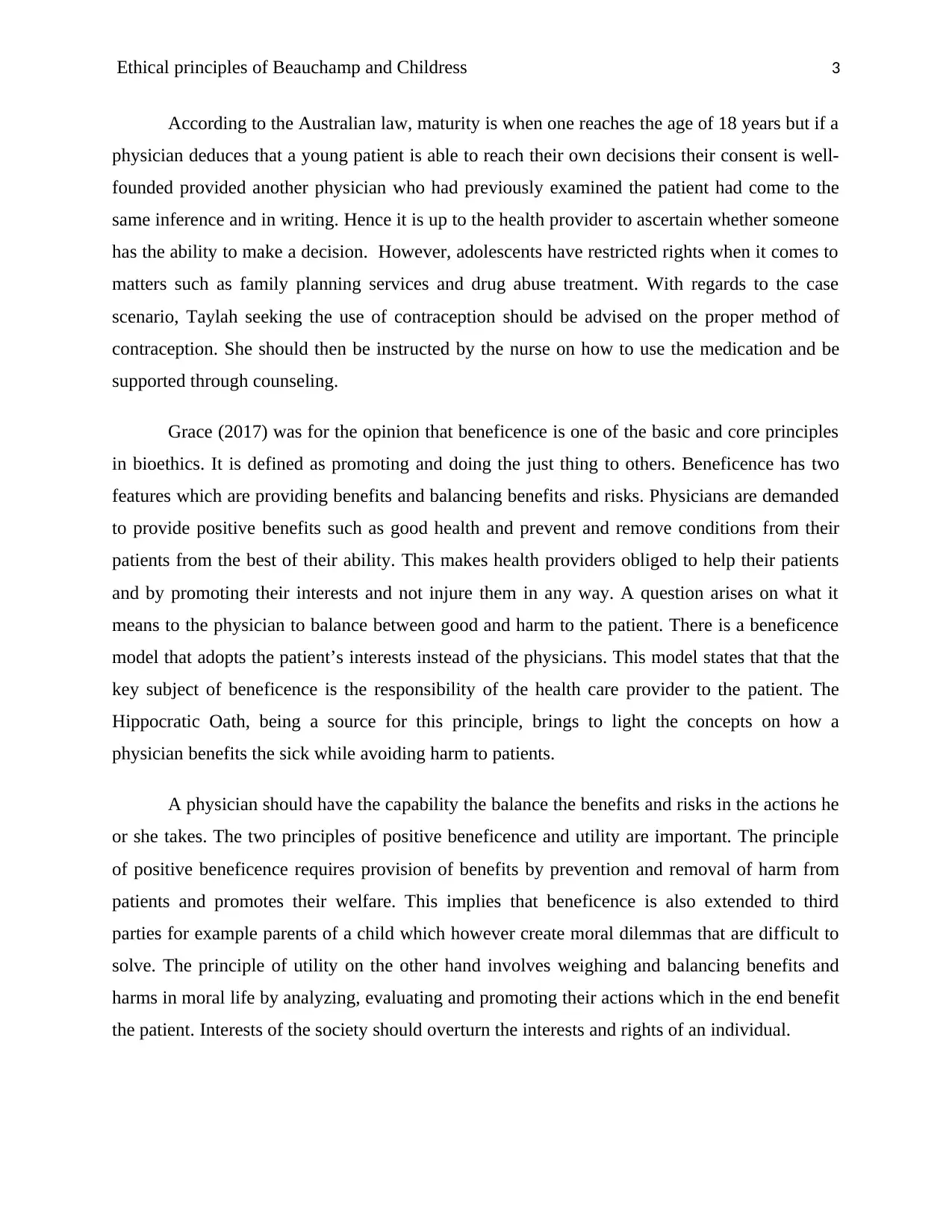
Ethical principles of Beauchamp and Childress 3
According to the Australian law, maturity is when one reaches the age of 18 years but if a
physician deduces that a young patient is able to reach their own decisions their consent is well-
founded provided another physician who had previously examined the patient had come to the
same inference and in writing. Hence it is up to the health provider to ascertain whether someone
has the ability to make a decision. However, adolescents have restricted rights when it comes to
matters such as family planning services and drug abuse treatment. With regards to the case
scenario, Taylah seeking the use of contraception should be advised on the proper method of
contraception. She should then be instructed by the nurse on how to use the medication and be
supported through counseling.
Grace (2017) was for the opinion that beneficence is one of the basic and core principles
in bioethics. It is defined as promoting and doing the just thing to others. Beneficence has two
features which are providing benefits and balancing benefits and risks. Physicians are demanded
to provide positive benefits such as good health and prevent and remove conditions from their
patients from the best of their ability. This makes health providers obliged to help their patients
and by promoting their interests and not injure them in any way. A question arises on what it
means to the physician to balance between good and harm to the patient. There is a beneficence
model that adopts the patient’s interests instead of the physicians. This model states that that the
key subject of beneficence is the responsibility of the health care provider to the patient. The
Hippocratic Oath, being a source for this principle, brings to light the concepts on how a
physician benefits the sick while avoiding harm to patients.
A physician should have the capability the balance the benefits and risks in the actions he
or she takes. The two principles of positive beneficence and utility are important. The principle
of positive beneficence requires provision of benefits by prevention and removal of harm from
patients and promotes their welfare. This implies that beneficence is also extended to third
parties for example parents of a child which however create moral dilemmas that are difficult to
solve. The principle of utility on the other hand involves weighing and balancing benefits and
harms in moral life by analyzing, evaluating and promoting their actions which in the end benefit
the patient. Interests of the society should overturn the interests and rights of an individual.
According to the Australian law, maturity is when one reaches the age of 18 years but if a
physician deduces that a young patient is able to reach their own decisions their consent is well-
founded provided another physician who had previously examined the patient had come to the
same inference and in writing. Hence it is up to the health provider to ascertain whether someone
has the ability to make a decision. However, adolescents have restricted rights when it comes to
matters such as family planning services and drug abuse treatment. With regards to the case
scenario, Taylah seeking the use of contraception should be advised on the proper method of
contraception. She should then be instructed by the nurse on how to use the medication and be
supported through counseling.
Grace (2017) was for the opinion that beneficence is one of the basic and core principles
in bioethics. It is defined as promoting and doing the just thing to others. Beneficence has two
features which are providing benefits and balancing benefits and risks. Physicians are demanded
to provide positive benefits such as good health and prevent and remove conditions from their
patients from the best of their ability. This makes health providers obliged to help their patients
and by promoting their interests and not injure them in any way. A question arises on what it
means to the physician to balance between good and harm to the patient. There is a beneficence
model that adopts the patient’s interests instead of the physicians. This model states that that the
key subject of beneficence is the responsibility of the health care provider to the patient. The
Hippocratic Oath, being a source for this principle, brings to light the concepts on how a
physician benefits the sick while avoiding harm to patients.
A physician should have the capability the balance the benefits and risks in the actions he
or she takes. The two principles of positive beneficence and utility are important. The principle
of positive beneficence requires provision of benefits by prevention and removal of harm from
patients and promotes their welfare. This implies that beneficence is also extended to third
parties for example parents of a child which however create moral dilemmas that are difficult to
solve. The principle of utility on the other hand involves weighing and balancing benefits and
harms in moral life by analyzing, evaluating and promoting their actions which in the end benefit
the patient. Interests of the society should overturn the interests and rights of an individual.
⊘ This is a preview!⊘
Do you want full access?
Subscribe today to unlock all pages.

Trusted by 1+ million students worldwide
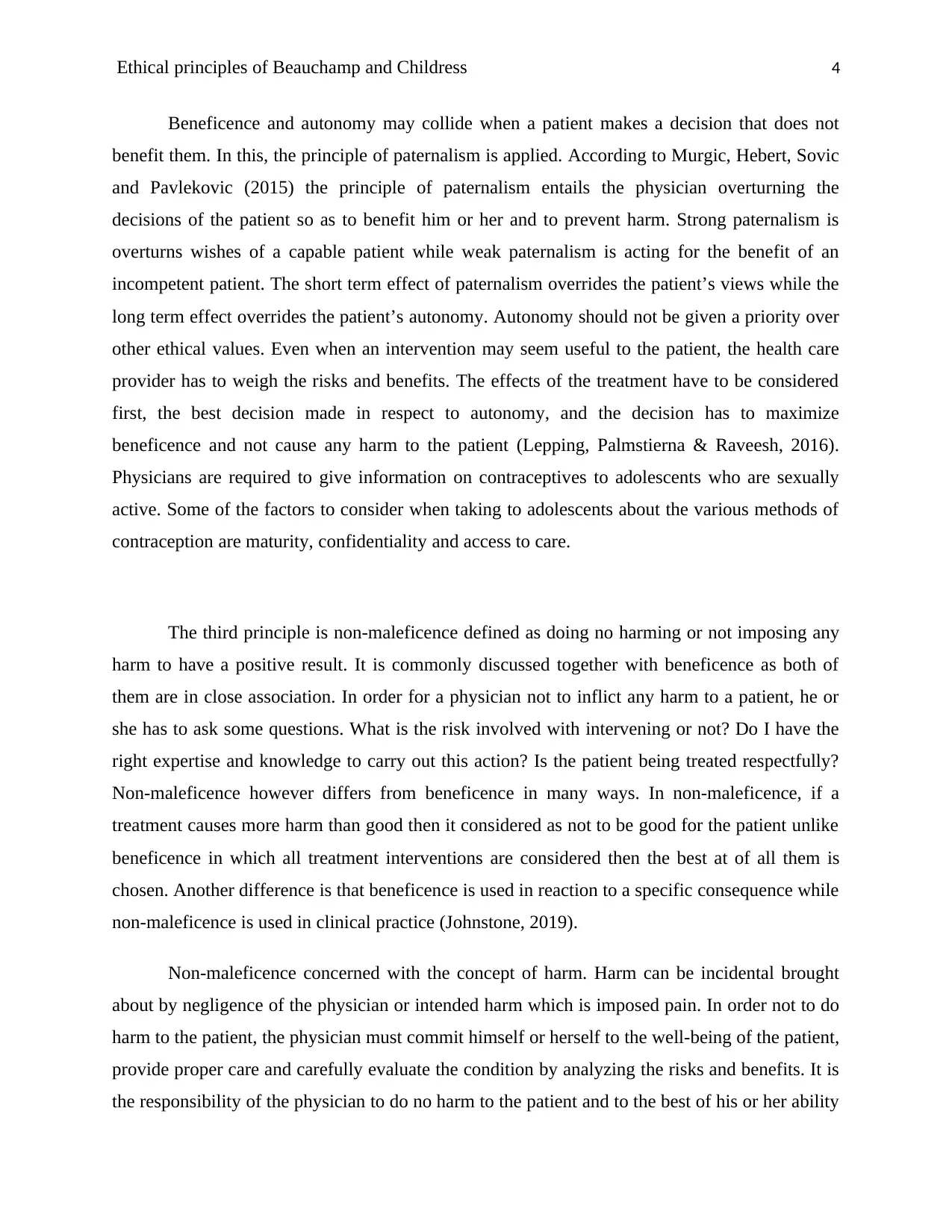
Ethical principles of Beauchamp and Childress 4
Beneficence and autonomy may collide when a patient makes a decision that does not
benefit them. In this, the principle of paternalism is applied. According to Murgic, Hebert, Sovic
and Pavlekovic (2015) the principle of paternalism entails the physician overturning the
decisions of the patient so as to benefit him or her and to prevent harm. Strong paternalism is
overturns wishes of a capable patient while weak paternalism is acting for the benefit of an
incompetent patient. The short term effect of paternalism overrides the patient’s views while the
long term effect overrides the patient’s autonomy. Autonomy should not be given a priority over
other ethical values. Even when an intervention may seem useful to the patient, the health care
provider has to weigh the risks and benefits. The effects of the treatment have to be considered
first, the best decision made in respect to autonomy, and the decision has to maximize
beneficence and not cause any harm to the patient (Lepping, Palmstierna & Raveesh, 2016).
Physicians are required to give information on contraceptives to adolescents who are sexually
active. Some of the factors to consider when taking to adolescents about the various methods of
contraception are maturity, confidentiality and access to care.
The third principle is non-maleficence defined as doing no harming or not imposing any
harm to have a positive result. It is commonly discussed together with beneficence as both of
them are in close association. In order for a physician not to inflict any harm to a patient, he or
she has to ask some questions. What is the risk involved with intervening or not? Do I have the
right expertise and knowledge to carry out this action? Is the patient being treated respectfully?
Non-maleficence however differs from beneficence in many ways. In non-maleficence, if a
treatment causes more harm than good then it considered as not to be good for the patient unlike
beneficence in which all treatment interventions are considered then the best at of all them is
chosen. Another difference is that beneficence is used in reaction to a specific consequence while
non-maleficence is used in clinical practice (Johnstone, 2019).
Non-maleficence concerned with the concept of harm. Harm can be incidental brought
about by negligence of the physician or intended harm which is imposed pain. In order not to do
harm to the patient, the physician must commit himself or herself to the well-being of the patient,
provide proper care and carefully evaluate the condition by analyzing the risks and benefits. It is
the responsibility of the physician to do no harm to the patient and to the best of his or her ability
Beneficence and autonomy may collide when a patient makes a decision that does not
benefit them. In this, the principle of paternalism is applied. According to Murgic, Hebert, Sovic
and Pavlekovic (2015) the principle of paternalism entails the physician overturning the
decisions of the patient so as to benefit him or her and to prevent harm. Strong paternalism is
overturns wishes of a capable patient while weak paternalism is acting for the benefit of an
incompetent patient. The short term effect of paternalism overrides the patient’s views while the
long term effect overrides the patient’s autonomy. Autonomy should not be given a priority over
other ethical values. Even when an intervention may seem useful to the patient, the health care
provider has to weigh the risks and benefits. The effects of the treatment have to be considered
first, the best decision made in respect to autonomy, and the decision has to maximize
beneficence and not cause any harm to the patient (Lepping, Palmstierna & Raveesh, 2016).
Physicians are required to give information on contraceptives to adolescents who are sexually
active. Some of the factors to consider when taking to adolescents about the various methods of
contraception are maturity, confidentiality and access to care.
The third principle is non-maleficence defined as doing no harming or not imposing any
harm to have a positive result. It is commonly discussed together with beneficence as both of
them are in close association. In order for a physician not to inflict any harm to a patient, he or
she has to ask some questions. What is the risk involved with intervening or not? Do I have the
right expertise and knowledge to carry out this action? Is the patient being treated respectfully?
Non-maleficence however differs from beneficence in many ways. In non-maleficence, if a
treatment causes more harm than good then it considered as not to be good for the patient unlike
beneficence in which all treatment interventions are considered then the best at of all them is
chosen. Another difference is that beneficence is used in reaction to a specific consequence while
non-maleficence is used in clinical practice (Johnstone, 2019).
Non-maleficence concerned with the concept of harm. Harm can be incidental brought
about by negligence of the physician or intended harm which is imposed pain. In order not to do
harm to the patient, the physician must commit himself or herself to the well-being of the patient,
provide proper care and carefully evaluate the condition by analyzing the risks and benefits. It is
the responsibility of the physician to do no harm to the patient and to the best of his or her ability
Paraphrase This Document
Need a fresh take? Get an instant paraphrase of this document with our AI Paraphraser
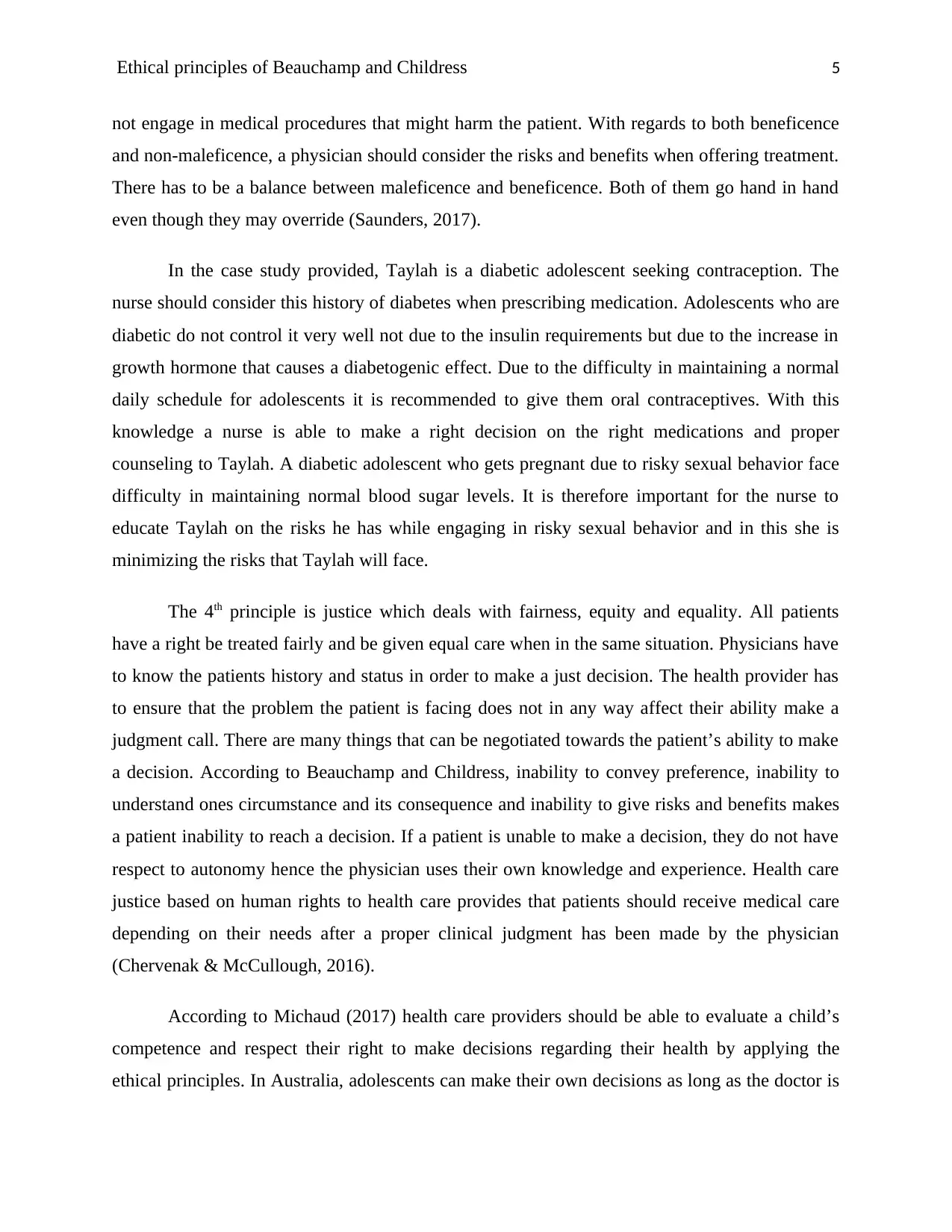
Ethical principles of Beauchamp and Childress 5
not engage in medical procedures that might harm the patient. With regards to both beneficence
and non-maleficence, a physician should consider the risks and benefits when offering treatment.
There has to be a balance between maleficence and beneficence. Both of them go hand in hand
even though they may override (Saunders, 2017).
In the case study provided, Taylah is a diabetic adolescent seeking contraception. The
nurse should consider this history of diabetes when prescribing medication. Adolescents who are
diabetic do not control it very well not due to the insulin requirements but due to the increase in
growth hormone that causes a diabetogenic effect. Due to the difficulty in maintaining a normal
daily schedule for adolescents it is recommended to give them oral contraceptives. With this
knowledge a nurse is able to make a right decision on the right medications and proper
counseling to Taylah. A diabetic adolescent who gets pregnant due to risky sexual behavior face
difficulty in maintaining normal blood sugar levels. It is therefore important for the nurse to
educate Taylah on the risks he has while engaging in risky sexual behavior and in this she is
minimizing the risks that Taylah will face.
The 4th principle is justice which deals with fairness, equity and equality. All patients
have a right be treated fairly and be given equal care when in the same situation. Physicians have
to know the patients history and status in order to make a just decision. The health provider has
to ensure that the problem the patient is facing does not in any way affect their ability make a
judgment call. There are many things that can be negotiated towards the patient’s ability to make
a decision. According to Beauchamp and Childress, inability to convey preference, inability to
understand ones circumstance and its consequence and inability to give risks and benefits makes
a patient inability to reach a decision. If a patient is unable to make a decision, they do not have
respect to autonomy hence the physician uses their own knowledge and experience. Health care
justice based on human rights to health care provides that patients should receive medical care
depending on their needs after a proper clinical judgment has been made by the physician
(Chervenak & McCullough, 2016).
According to Michaud (2017) health care providers should be able to evaluate a child’s
competence and respect their right to make decisions regarding their health by applying the
ethical principles. In Australia, adolescents can make their own decisions as long as the doctor is
not engage in medical procedures that might harm the patient. With regards to both beneficence
and non-maleficence, a physician should consider the risks and benefits when offering treatment.
There has to be a balance between maleficence and beneficence. Both of them go hand in hand
even though they may override (Saunders, 2017).
In the case study provided, Taylah is a diabetic adolescent seeking contraception. The
nurse should consider this history of diabetes when prescribing medication. Adolescents who are
diabetic do not control it very well not due to the insulin requirements but due to the increase in
growth hormone that causes a diabetogenic effect. Due to the difficulty in maintaining a normal
daily schedule for adolescents it is recommended to give them oral contraceptives. With this
knowledge a nurse is able to make a right decision on the right medications and proper
counseling to Taylah. A diabetic adolescent who gets pregnant due to risky sexual behavior face
difficulty in maintaining normal blood sugar levels. It is therefore important for the nurse to
educate Taylah on the risks he has while engaging in risky sexual behavior and in this she is
minimizing the risks that Taylah will face.
The 4th principle is justice which deals with fairness, equity and equality. All patients
have a right be treated fairly and be given equal care when in the same situation. Physicians have
to know the patients history and status in order to make a just decision. The health provider has
to ensure that the problem the patient is facing does not in any way affect their ability make a
judgment call. There are many things that can be negotiated towards the patient’s ability to make
a decision. According to Beauchamp and Childress, inability to convey preference, inability to
understand ones circumstance and its consequence and inability to give risks and benefits makes
a patient inability to reach a decision. If a patient is unable to make a decision, they do not have
respect to autonomy hence the physician uses their own knowledge and experience. Health care
justice based on human rights to health care provides that patients should receive medical care
depending on their needs after a proper clinical judgment has been made by the physician
(Chervenak & McCullough, 2016).
According to Michaud (2017) health care providers should be able to evaluate a child’s
competence and respect their right to make decisions regarding their health by applying the
ethical principles. In Australia, adolescents can make their own decisions as long as the doctor is
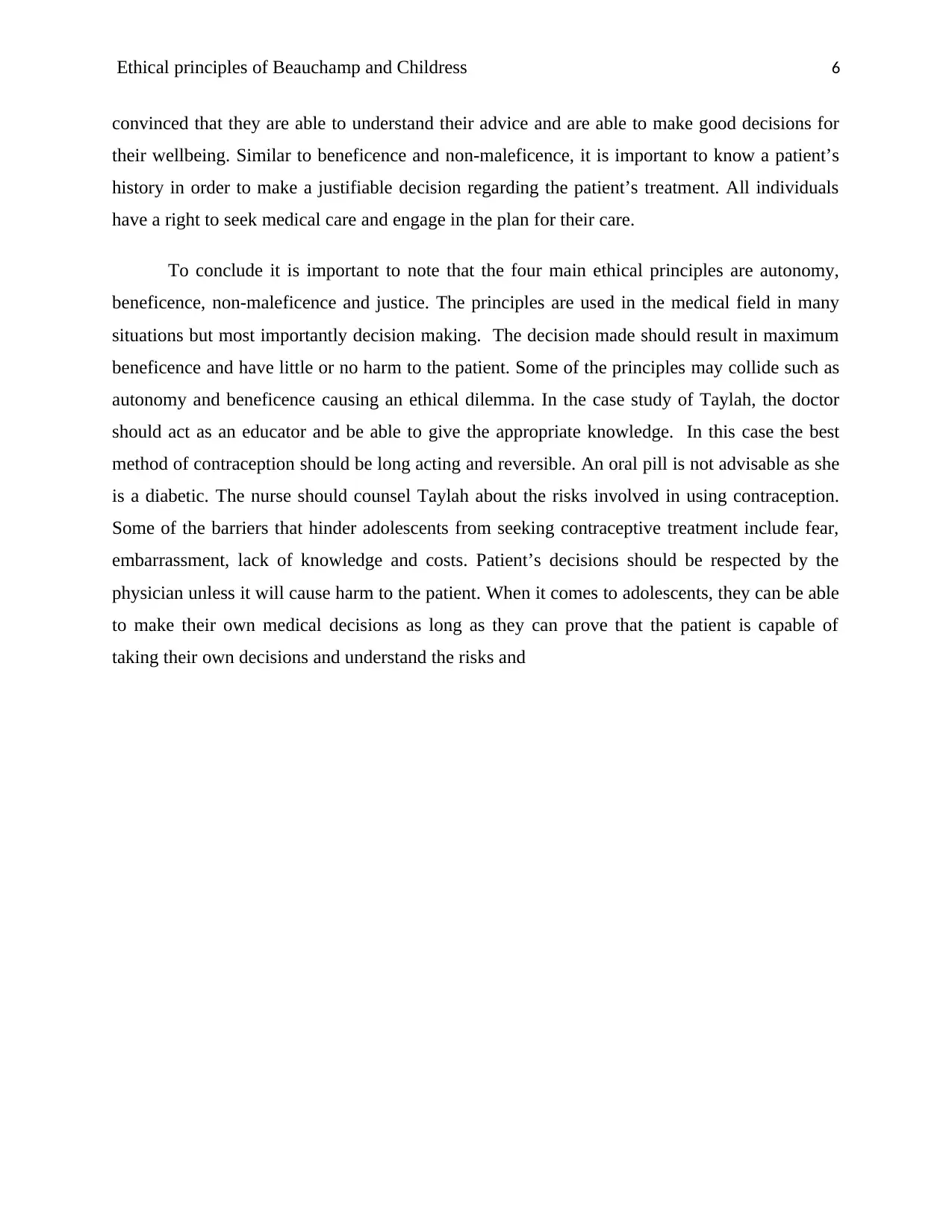
Ethical principles of Beauchamp and Childress 6
convinced that they are able to understand their advice and are able to make good decisions for
their wellbeing. Similar to beneficence and non-maleficence, it is important to know a patient’s
history in order to make a justifiable decision regarding the patient’s treatment. All individuals
have a right to seek medical care and engage in the plan for their care.
To conclude it is important to note that the four main ethical principles are autonomy,
beneficence, non-maleficence and justice. The principles are used in the medical field in many
situations but most importantly decision making. The decision made should result in maximum
beneficence and have little or no harm to the patient. Some of the principles may collide such as
autonomy and beneficence causing an ethical dilemma. In the case study of Taylah, the doctor
should act as an educator and be able to give the appropriate knowledge. In this case the best
method of contraception should be long acting and reversible. An oral pill is not advisable as she
is a diabetic. The nurse should counsel Taylah about the risks involved in using contraception.
Some of the barriers that hinder adolescents from seeking contraceptive treatment include fear,
embarrassment, lack of knowledge and costs. Patient’s decisions should be respected by the
physician unless it will cause harm to the patient. When it comes to adolescents, they can be able
to make their own medical decisions as long as they can prove that the patient is capable of
taking their own decisions and understand the risks and
convinced that they are able to understand their advice and are able to make good decisions for
their wellbeing. Similar to beneficence and non-maleficence, it is important to know a patient’s
history in order to make a justifiable decision regarding the patient’s treatment. All individuals
have a right to seek medical care and engage in the plan for their care.
To conclude it is important to note that the four main ethical principles are autonomy,
beneficence, non-maleficence and justice. The principles are used in the medical field in many
situations but most importantly decision making. The decision made should result in maximum
beneficence and have little or no harm to the patient. Some of the principles may collide such as
autonomy and beneficence causing an ethical dilemma. In the case study of Taylah, the doctor
should act as an educator and be able to give the appropriate knowledge. In this case the best
method of contraception should be long acting and reversible. An oral pill is not advisable as she
is a diabetic. The nurse should counsel Taylah about the risks involved in using contraception.
Some of the barriers that hinder adolescents from seeking contraceptive treatment include fear,
embarrassment, lack of knowledge and costs. Patient’s decisions should be respected by the
physician unless it will cause harm to the patient. When it comes to adolescents, they can be able
to make their own medical decisions as long as they can prove that the patient is capable of
taking their own decisions and understand the risks and
⊘ This is a preview!⊘
Do you want full access?
Subscribe today to unlock all pages.

Trusted by 1+ million students worldwide
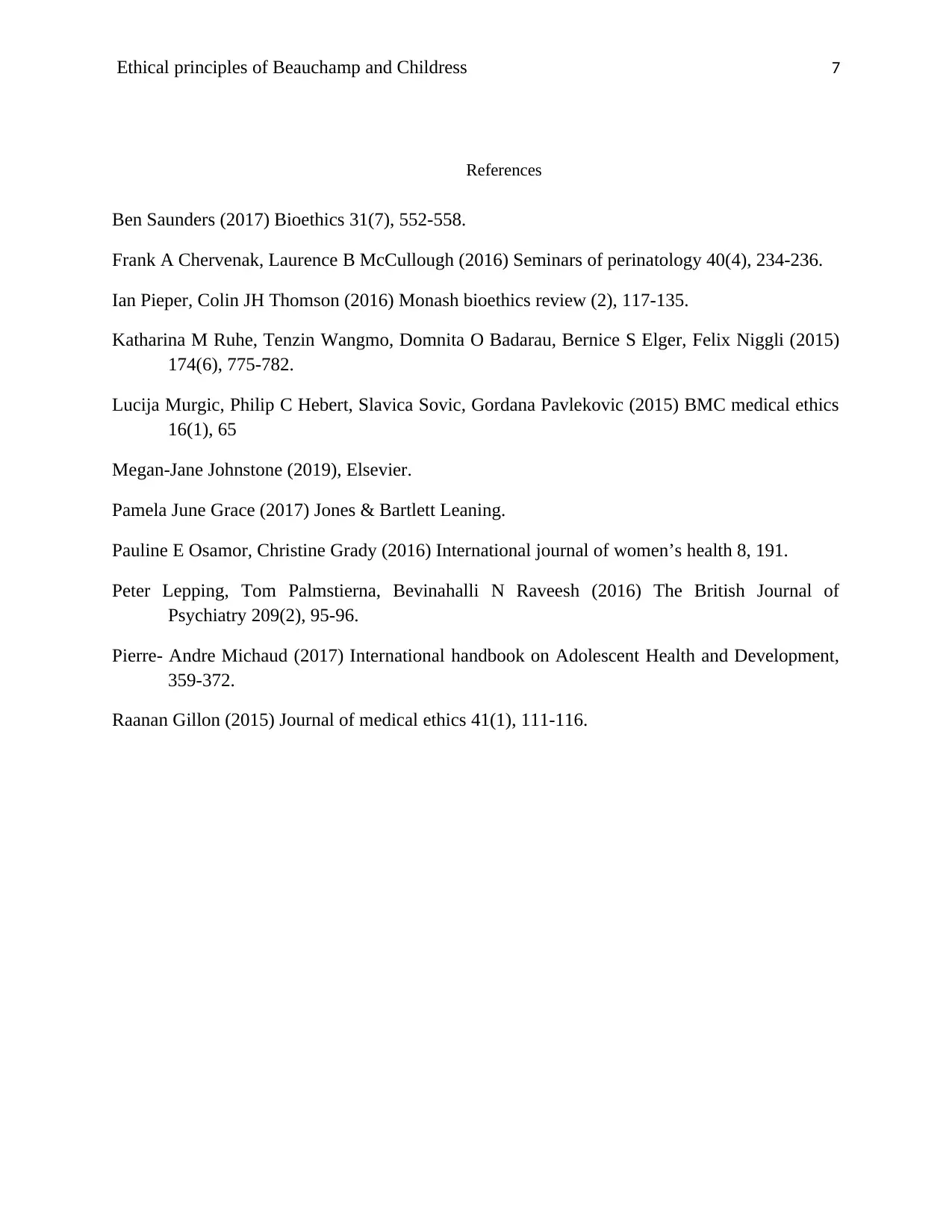
Ethical principles of Beauchamp and Childress 7
References
Ben Saunders (2017) Bioethics 31(7), 552-558.
Frank A Chervenak, Laurence B McCullough (2016) Seminars of perinatology 40(4), 234-236.
Ian Pieper, Colin JH Thomson (2016) Monash bioethics review (2), 117-135.
Katharina M Ruhe, Tenzin Wangmo, Domnita O Badarau, Bernice S Elger, Felix Niggli (2015)
174(6), 775-782.
Lucija Murgic, Philip C Hebert, Slavica Sovic, Gordana Pavlekovic (2015) BMC medical ethics
16(1), 65
Megan-Jane Johnstone (2019), Elsevier.
Pamela June Grace (2017) Jones & Bartlett Leaning.
Pauline E Osamor, Christine Grady (2016) International journal of women’s health 8, 191.
Peter Lepping, Tom Palmstierna, Bevinahalli N Raveesh (2016) The British Journal of
Psychiatry 209(2), 95-96.
Pierre- Andre Michaud (2017) International handbook on Adolescent Health and Development,
359-372.
Raanan Gillon (2015) Journal of medical ethics 41(1), 111-116.
References
Ben Saunders (2017) Bioethics 31(7), 552-558.
Frank A Chervenak, Laurence B McCullough (2016) Seminars of perinatology 40(4), 234-236.
Ian Pieper, Colin JH Thomson (2016) Monash bioethics review (2), 117-135.
Katharina M Ruhe, Tenzin Wangmo, Domnita O Badarau, Bernice S Elger, Felix Niggli (2015)
174(6), 775-782.
Lucija Murgic, Philip C Hebert, Slavica Sovic, Gordana Pavlekovic (2015) BMC medical ethics
16(1), 65
Megan-Jane Johnstone (2019), Elsevier.
Pamela June Grace (2017) Jones & Bartlett Leaning.
Pauline E Osamor, Christine Grady (2016) International journal of women’s health 8, 191.
Peter Lepping, Tom Palmstierna, Bevinahalli N Raveesh (2016) The British Journal of
Psychiatry 209(2), 95-96.
Pierre- Andre Michaud (2017) International handbook on Adolescent Health and Development,
359-372.
Raanan Gillon (2015) Journal of medical ethics 41(1), 111-116.
1 out of 7
Related Documents
Your All-in-One AI-Powered Toolkit for Academic Success.
+13062052269
info@desklib.com
Available 24*7 on WhatsApp / Email
![[object Object]](/_next/static/media/star-bottom.7253800d.svg)
Unlock your academic potential
Copyright © 2020–2025 A2Z Services. All Rights Reserved. Developed and managed by ZUCOL.





